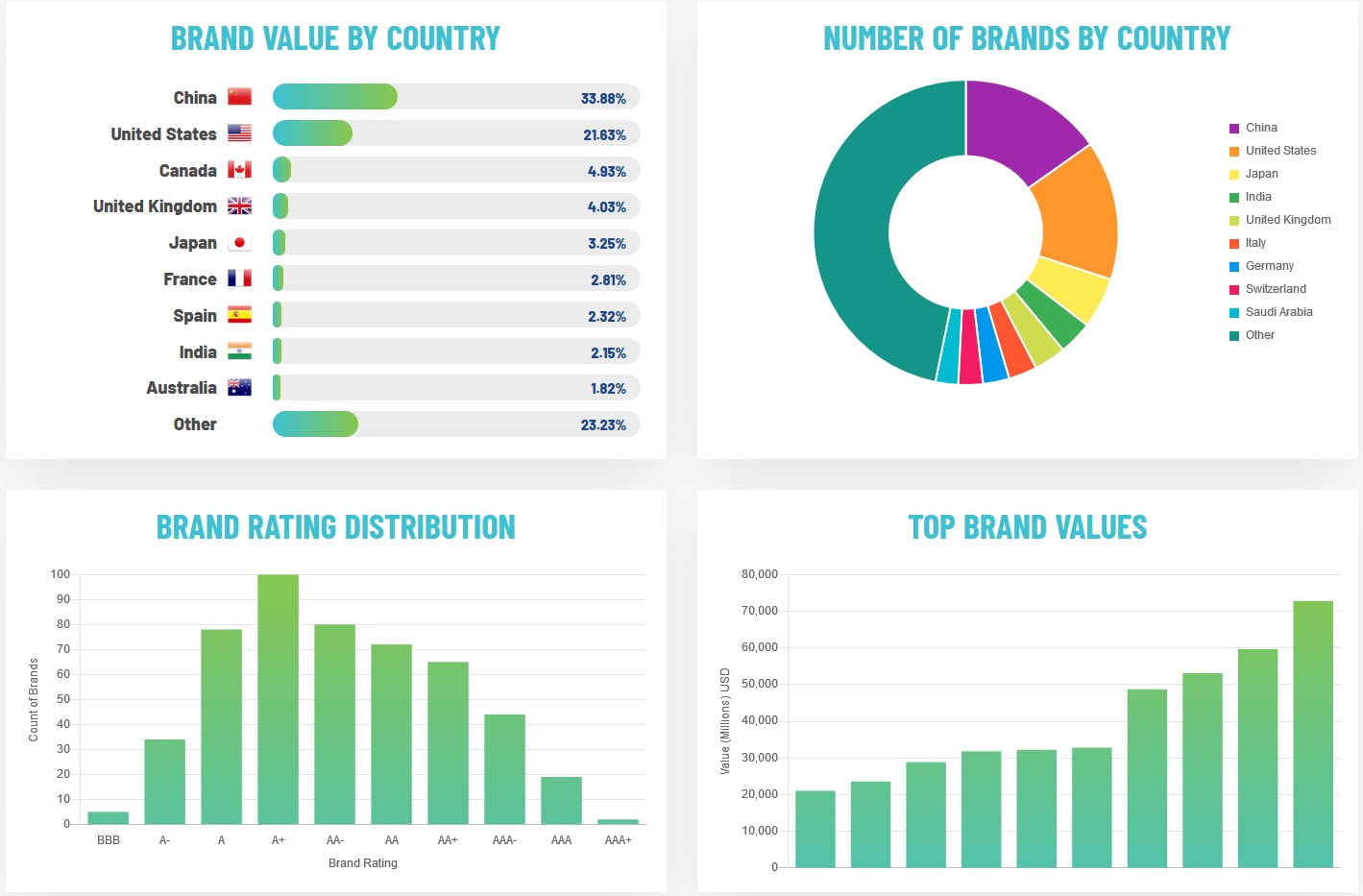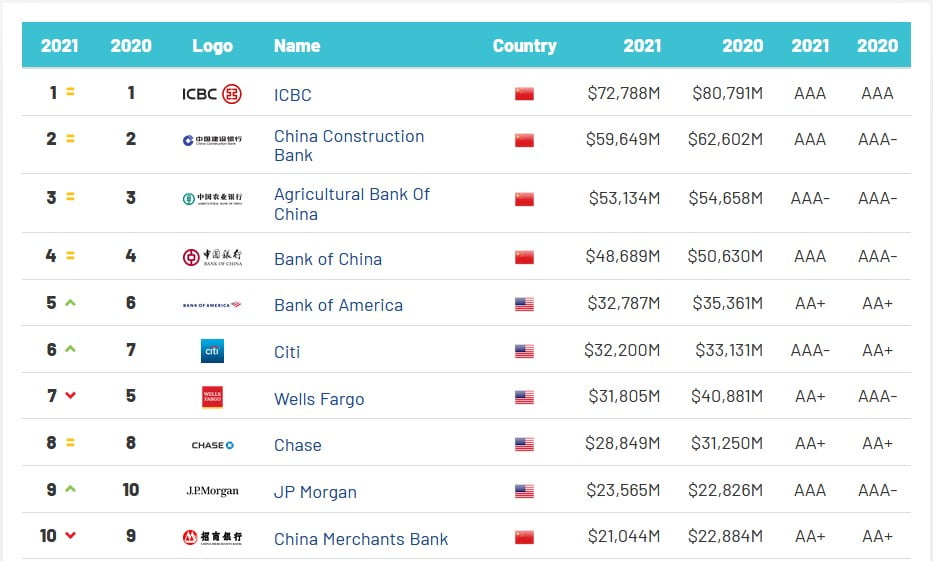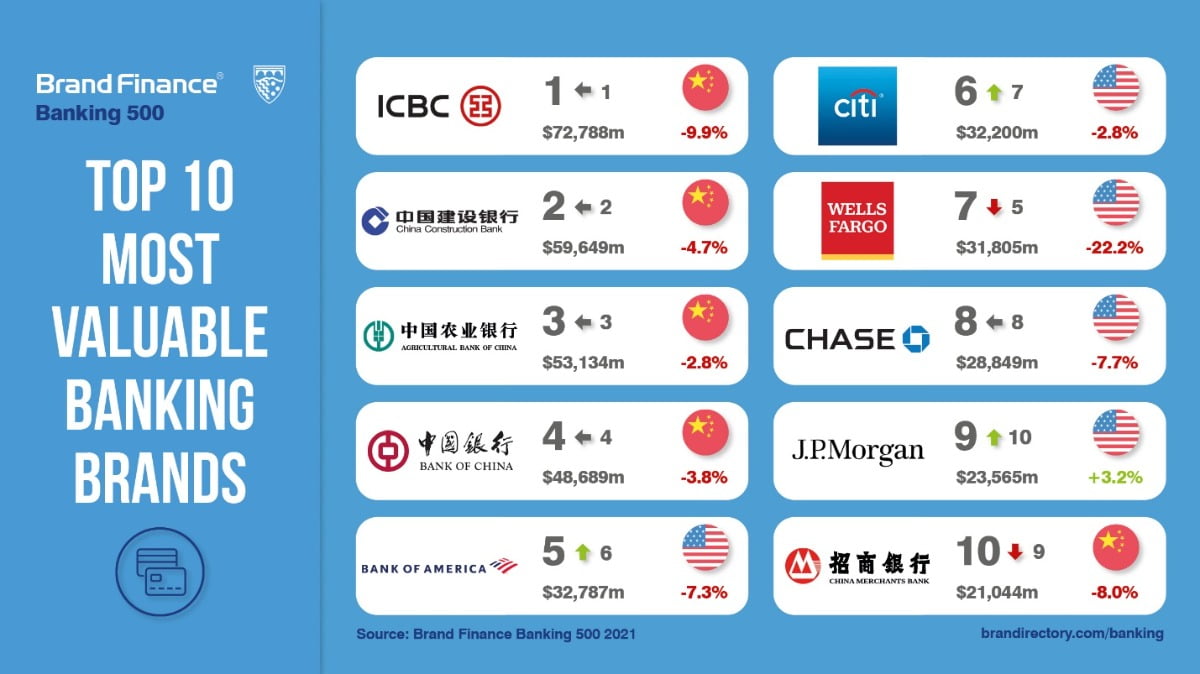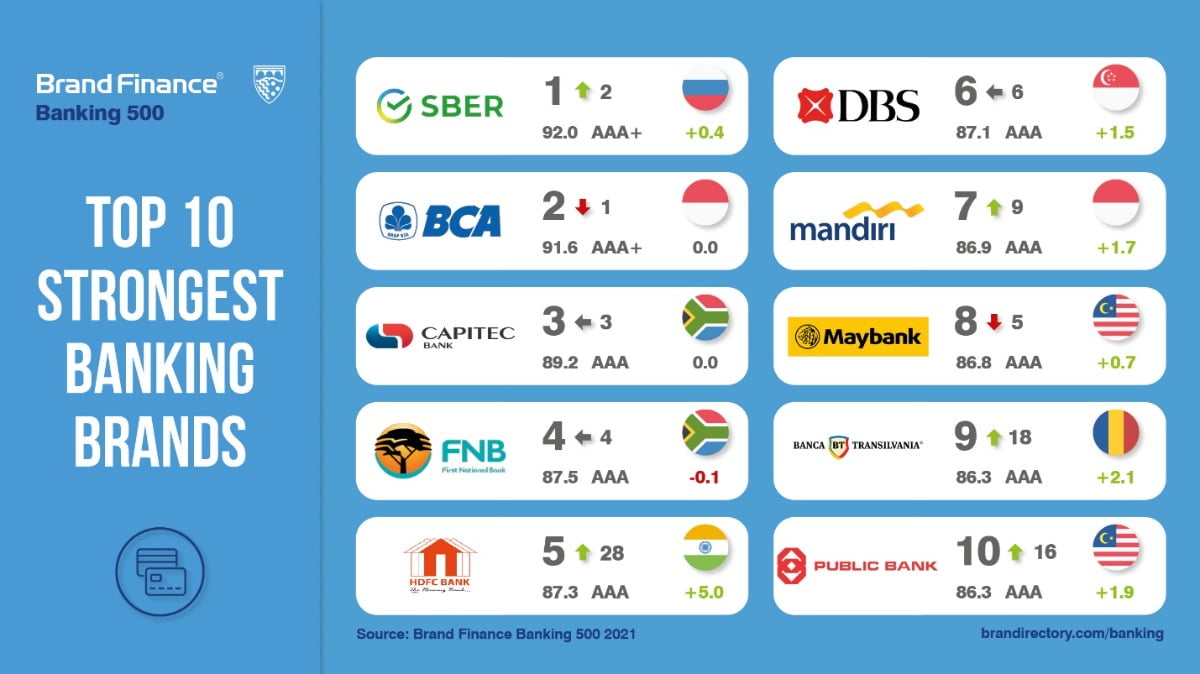Brand Value of World’s Largest Banks Contracts for Second Year Running but Reputation Redemption Could Signal Road to Recovery in Pandemic Aftermath
Q4 2020 hedge fund letters, conferences and more
Bank of America Reclaims Title of Most Valuable US Banking Brand for First Time in 10 Years
- World’s most valuable banking brands suffer severe decline in brand value following devastating effects of COVID-19 pandemic, two-thirds record brand value loss
- Five US banks make top 10, with Bank of America claiming top spot in US after 10 years and raking 5th overall – JP Morgan only bank in top 10 to record brand value growth, up 3%
- US banks account for almost a quarter of the total brand value in the ranking, with 74 banks reaching cumulative brand value US$274.8 billion
- Chinese banks make up one-third of total brand value in Brand Finance Banking 500 2021 ranking, with ICBC retaining title of world’s most valuable banking brand - brand value US$72.8 billion
- 23 new entrants in ranking this year, with Truist entering in 36th position
- Sber overtakes BCA to become world’s strongest banking brand, with a Brand Strength Index (BSI) score of 92.0 out of 100 and an elite AAA+ rating
Most Valuable Banking Brands Have Recorded Brand Value Losses
As governments scramble to stimulate economic growth in the face of the ongoing global health crisis, and profits and interest rates take a hit, nearly two-thirds of the world’s 500 most valuable banking brands have recorded brand value losses, according to the latest report by Brand Finance – the world’s leading brand valuation consultancy as published by The Banker magazine today.
The industry has seen a dramatic downturn in the past two years when compared with previous year-on-year performance. The total brand value in the annual Brand Finance Banking 500 ranking increased by 10% in 2018 (from US$1.07 trillion to US$1.18 trillion) and again by 15% in 2019 (US$1.36 trillion) but decreased by 2% and 4% in 2020 (US$1.33 trillion) and 2021 (US$1.27 trillion), respectively.
The economic impacts of the COVID-19 pandemic are difficult to ignore, with global GDP forecasted to shrink by over 4%, which would signal the largest global recession since the Second World War.
Analyses conducted by Brand Finance on the world’s most valuable brands over three recessionary periods indicate that, on average, of the 100 brands that lost the most brand value during each recession, 74 of them were banks. On the other hand, of the 100 most successful brands during the recessions, 30 were banks.
Apart from calculating brand value, Brand Finance also determines the relative strength of brands through a balanced scorecard of metrics evaluating marketing investment, stakeholder equity, and business performance. Alongside revenue forecasts, brand strength is a crucial driver of brand value. Banks with a Brand Strength Index (BSI) score below 60 out of 100 experienced an average decline in brand value of 20%, whereas of the banks with a BSI score above 70, the average fall in brand value was only 8% – proving just how important it is for banks to have stronger brands than their competitors during an economic downturn.
David Haigh, CEO of Brand Finance, commented:
“Banking institutions were the main culprit in the last financial crash; this time around they are a large part of helping people overcome the repercussions of COVID-19. Brand Finance research shows that banks’ responses to the global pandemic have led to a year-on-year increase in overall reputation scores among customers, which no doubt could result in an uptick in brand values in the coming year.”
“The widespread shift to digital has also opened up opportunities for banks to deliver better customer service and faster innovations, which goes a long way in enhancing brand awareness and value,” added Joy Macknight, managing editor of The Banker. “Those banks that have been investing time and resources in the digital transformation of their operations over the past few years have seen that investment pay off during the pandemic, as they were able to quickly respond to new customer needs.”
Bank of America claims 5th spot
US banks account for almost a quarter of the total brand value in the ranking - the nation’s 74 banks reaching a cumulative brand value of US$274.8 billion. Five US brands feature in the top 10: Bank of America (down 7% to US$32.8 billion), Citi (down 3%to US$32.2 billion), Wells Fargo (down 22% to US$31.8 billion), Chase (down 8% to US$28.8 billion), and JP Morgan (up 3% to US$23.6 billion).
Reclaiming top spot as the most valuable US banking brand for the first time in a decade, Bank of America simultaneously places fifth globally, while JP Morgan is the only brand in the top ten to record a positive value change.
Citi, the third largest US bank by assets, has emerged as the strongest retail bank in the US with a BSI score of 80.7 out of 100 and AAA- rating (up from AA+ in 2020). Citi has also climbed one place in the ranking to 6th position, following a rapid rebound in its profits in the third quarter of last year. Currently holding the lowest reputation score among all banks in the US, Wells Fargo experienced the largest drop in brand value – falling two places to seventh overall, and third in the US – the result of failing to rebuild favour among consumers in the wake of several past scandals.
Chinese banks maintain dominance
Chinese banks maintain dominance of the Brand Finance Banking 500 2021 ranking, accounting for one-third of total brand value and seven of the ten top climbers by absolute brand value. Chinese banks have been largely impervious to the issues plaguing their counterparts elsewhere in the world – as two-thirds of brands in the ranking have experienced losses, Chinese banks recorded a healthy 3% average brand value growth. This is largely attributable to the banking sector’s role in China’s timely and effective response to COVID-19, which included regulatory policy adjustments for asset management, wealth management, and inter-banking, as well as increased investment into digitalisation.
Despite a 10% drop in brand value to US$72.8 billion, ICBC remains the world’s most valuable banking brand. As the biggest bank in China, ICBC continues to fare well with consumers, regardless of the bank’s depreciating brand value due to the pandemic’s negative impact on its investment portfolio return. Nonetheless, the brand maintains a healthy lead ahead of China Construction Bank (down 5% to US$59.6 billion) and Agricultural Bank of China (down 3% to US$53.1 billion), which come in at 2nd and 3rd place in the ranking, respectively.
China Guangfa Bank is also a remarkable addition to the country’s portfolio, entering the Brand Finance Banking 500 2021 ranking for the first time at an impressive 84th position and valued at US$3.3 billion. The Hong Kong Monetary Authority recently granted China Guangfa Bank a banking licence, widening its footprint outside of mainland China.
David Haigh, CEO of Brand Finance, commented:
“Chinese banks have scored extremely well in Brand Finance’s Global Brand Equity Monitor research this year, ranking highly for attributes such as recommendation. This is undoubtedly an effect of China’s management of the COVID-19 pandemic, which has allowed its economy to continue functioning relatively unscathed, allowing space for banks to grow further.”
Ones to watch
While some of the world’s largest banks have floundered during the pandemic, 23 insurgent newcomers have joined the ranking, hailing from Europe, Asia, the US, and South America.
The highest new entrant is Truist at 36th position, with a brand value of US$8.0 billion. Formed in 2019 – a result of a merger between BB&T and SunTrust, which sat in 68th and 86th in the 2019 iteration of the Brand Finance Banking 500 ranking, respectively, with a combined brand value of US$7.2 billion. This merger is testament to the power of rebranding and a revised strategy, demonstrating that brands can be reinvigorated even in the face of a global crisis.
Sber overtakes BCA as sector’s strongest
Sber has been increasing in brand strength year-on-year to become the strongest brand in the Brand Finance Banking 500 2021 ranking and the world’s third strongest brand across all sectors in the Brand Finance Global 500, with a Brand Strength Index (BSI) score of 92.0 out of 100 and a coveted AAA+ brand strength rating.
As the largest bank in Russia, Sber has benefitted from its stable brand and high levels of customer loyalty. These have only been boosted by the recent rebranding to consolidate its ecosystem of services – encompassing banking, health, and logistics, among others – around the Sber brand. Sber is poised for further success, as the company’s pledge to spend more on its brand in the coming year is likely to further boost its BSI score.
In Brand Finance’s original market research, Sber consistently outperforms its peers in overall reputation and familiarity – it is widely known, always top-of-mind, and well-regarded. As a result, recommendation is high. Its ubiquitous presence and – in consumers’ eyes – by far the best digital offering ensure high mental and physical availability, which are strong foundations for brand strength.
David Haigh, CEO of Brand Finance, commented:
“Sber’s successful rebranding as a cross-sector tech brand can be an example to other market leaders worldwide. While some rest on their laurels and are often surprised by disruptive challengers, Sber is focused on the future, innovating and modernising with their customers’ best interests in mind.”
Despite this success, Sber is not divorced from the wider issues stemming from the COVID-19 pandemic. Sber’s 13% brand value drop in local currency terms has been exacerbated by the increased risk in the Russian economy, following the mid-year collapse in oil prices and the subsequent weakening of the Russian ruble, resulting in an overall 29% drop in USD terms to US$9.4 billion.
As the second strongest brand in the ranking, Indonesia’s BCA has maintained its BSI score of 91.6 out of 100 and is the only brand aside from Sber to have been awarded an elite brand strength rating of AAA+. The brand remains one of the biggest banks in the ASEAN region and has the largest market capitalisation value on the Indonesian Stock Exchange.
South Africa provides the third strongest banking brand this year, Capitec Bank, which has maintained its BSI score of 89.2 out of 100 and corresponding AAA rating. Surpassing the 15 million client mark in December 2020, Capitec has more customers than any other South African bank, benefiting from its excellent customer service and personalised banking experience. Fellow South African brand, First National Bank, in 4th place for brand strength globally, is also the most valuable bank in all of Africa with a brand value of US$1.3 billion.
David Haigh, CEO of Brand Finance, commented:
“Few sectors have been as detrimentally affected by the COVID-19 pandemic as the banking industry, reflected in the overall brand value decline this year. Within this context, Sber, BCA, and Capitec Bank have fared extremely well, retaining their elite brand strength ratings through positive reputations and consumer perceptions of their brands.”
About Brand Finance
Brand Finance is the world’s leading brand valuation consultancy. Bridging the gap between marketing and finance, Brand Finance evaluates the strength of brands and quantifies their financial value to help organisations of all kinds make strategic decisions.
Headquartered in London, Brand Finance has offices in over 20 countries, offering services on all continents. Every year, Brand Finance conducts more than 5,000 brand valuations, supported by original market research, and publishes nearly 100 reports which rank brands across all sectors and countries.
Brand Finance is a regulated accountancy firm, leading the standardisation of the brand valuation industry. Brand Finance was the first to be certified by independent auditors as compliant with both ISO 10668 and ISO 20671, and has received the official endorsement of the Marketing Accountability Standards Board (MASB) in the United States.
About The Banker
The Banker provides economic and financial intelligence for the world's financial sector and has built a reputation for objective and incisive reporting. It leads the debate on all the issues surrounding the global banking industry, providing in-depth news and analysis, exclusive interviews with senior industry figures and definitive regional bank listings, including the internationally acclaimed Top 1000 World Banks ranking.
Methodology
Definition of Brand
Brand is defined as a marketing-related intangible asset including, but not limited to, names, terms, signs, symbols, logos, and designs, intended to identify goods, services, or entities, creating distinctive images and associations in the minds of stakeholders, thereby generating economic benefits.
Brand Value
Brand value refers to the present value of earnings specifically related to brand reputation. Organisations own and control these earnings by owning trademark rights.
All brand valuation methodologies are essentially trying to identify this, although the approach and assumptions differ. As a result, published brand values can be different.
These differences are similar to the way equity analysts provide business valuations that are different to one another. The only way you find out the “real” value is by looking at what people really pay.
As a result, Brand Finance always incorporates a review of what users of brands actually pay for the use of brands in the form of brand royalty agreements, which are found in more or less every sector in the world.
This is known as the “Royalty Relief” methodology and is by far the most widely used approach for brand valuations since it is grounded in reality.
It is the basis for our public rankings but we always augment it with a real understanding of people’s perceptions and their effects on demand – from our database of market research on over 3000 brands in over 30 markets.
Brand Valuation Methodology
For our rankings, Brand Finance uses the simplest method possible to help readers understand, gain trust in, and actively use brand valuations.
Brand Finance calculates the values of brands in its rankings using the Royalty Relief approach – a brand valuation method compliant with the industry standards set in ISO 10668.
Our Brand Strength Index assessment, a balanced scorecard of brand-related measures, is also compliant with international standards (ISO 20671) and operates as a predictive tool of future brand value changes and a control panel to help business improving marketing.
We do this in the following four steps:
- Brand Impact
We review what brands already pay in royalty agreements. This is augmented by an analysis of how brands impact profitability in the sector versus generic brands.
This results in a range of possible royalties that could be charged in the sector for brands (for example a range of 0% to 2% of revenue).
- Brand Strength
We adjust the rate higher or lower for brands by analysing Brand Strength. We analyse brand strength by looking at three core pillars: “Investment” which are activities supporting the future strength of the brand; “Equity” which are real perceptions sourced from our original market research and other data partners; “Performance” which are brand-related measures of business results, such as market share.
Each brand is assigned a Brand Strength Index (BSI) score out of 100, which feeds into the brand value calculation. Based on the score, each brand is assigned a corresponding Brand Rating up to AAA+, in a format similar to a credit rating.
- Brand Impact x Brand Strength
The BSI score is applied to the royalty range to arrive at a royalty rate. For example, if the royalty range in a sector is 0-5% and a brand has a BSI score of 80 out of 100, then an appropriate royalty rate for the use of this brand in the given sector will be 4%.
- Brand Value Calculation
We determine brand-specific revenues as a proportion of parent company revenues attributable to the brand in question and forecast those revenues by analysing historic revenues, equity analyst forecasts, and economic growth rates.
We then apply the royalty rate to the forecast revenues to derive brand revenues and apply the relevant valuation assumptions to arrive at a discounted, post-tax present value which equals the brand value.









